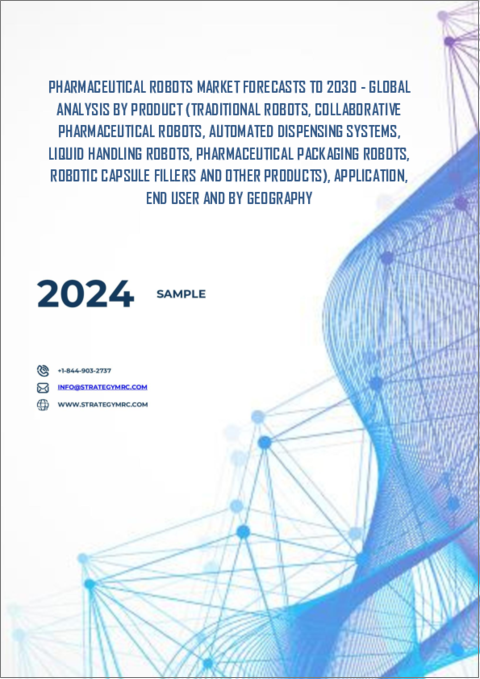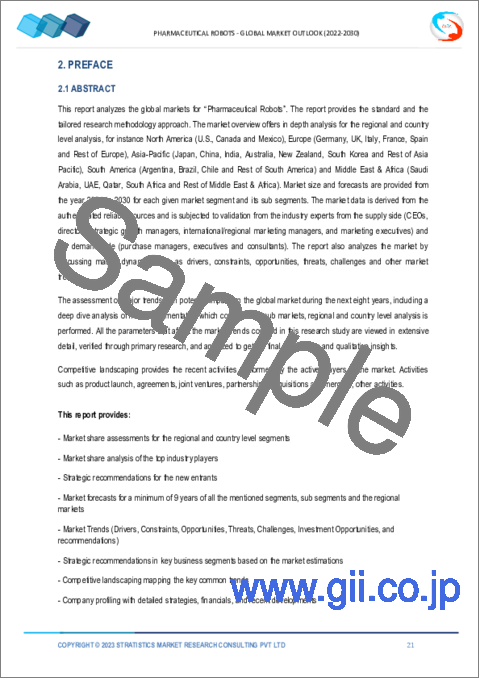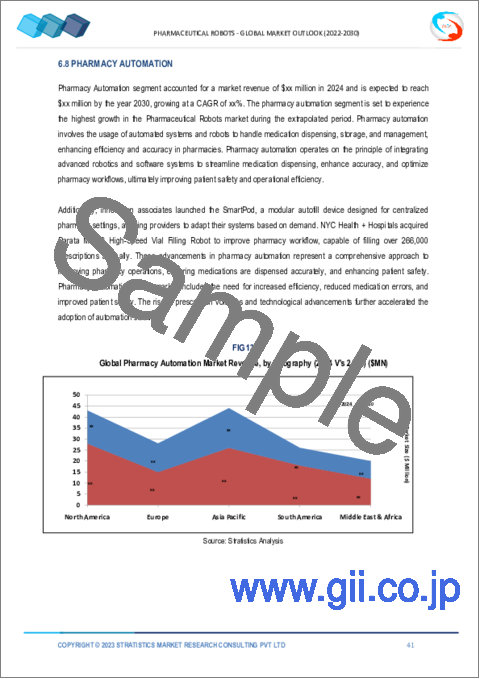|
|
市場調査レポート
商品コード
1383479
製薬用ロボットの2030年市場予測:製品別、用途別、エンドユーザー別、地域別の世界分析Pharmaceutical Robots Market Forecasts to 2030 - Global Analysis By Product, Application, End User and By Geography |
||||||
カスタマイズ可能
|
|||||||
| 製薬用ロボットの2030年市場予測:製品別、用途別、エンドユーザー別、地域別の世界分析 |
|
出版日: 2023年11月01日
発行: Stratistics Market Research Consulting
ページ情報: 英文 200+ Pages
納期: 2~3営業日
|
- 全表示
- 概要
- 図表
- 目次
Stratistics MRCによると、世界の製薬用ロボット市場は2023年に2億425万米ドルを占め、予測期間中のCAGRは15.2%で成長し、2030年には5億4,996万米ドルに達すると予測されています。
製薬用ロボット市場は、ヘルスケアおよび製薬業界のサブセットであり、さまざまな製薬プロセスやアプリケーションにおけるロボット技術と自動化の利用に焦点を当てています。これらの専門ロボットは、医薬品の製造、創薬、サンプルハンドリング、ラボの自動化、梱包などを行うように設計されています。製薬用ロボットは精密さ、一貫性、効率性を提供し、人為的なミスや汚染のリスクを下げることで、医薬品の品質と安全性を向上させる。
CNBCが発表したデータによると、2020年6月、米国の累積失業率は2020年4月の14.7%から2020年5月には13.3%に減少しました。一方、製造業全体の雇用率は2020年1月から2020年4月にかけて19.1%の割合で減少し、急激な縮小に直面しているため、製造業者の30%はCOVID-19パンデミックの間、新規雇用を求めていると述べています。
無菌環境に対するニーズの高まり
医薬品製造、特に生物製剤の製造においては、汚染を防ぎ、医薬品の安全性と有効性を確保するために、無菌状態が不可欠です。製薬用ロボットは、クリーンルーム環境や無菌環境下で機能するよう特別に設計されており、高い無菌基準を達成するための貴重な資産となっています。製薬業界がバイオ医薬品や無菌処理に力を入れるにつれて、無菌状態で機能する製薬用ロボットの需要が高まっています。これらのロボットは医薬品の品質と安全性を向上させるだけでなく、無菌製造プロセスの最適化にも貢献し、結果として製薬用ロボット市場の成長の重要な原動力となっています。
高いイニシャルコスト
ロボット自体の購入、現在の製薬プロセスへの統合、機器の操作や保守を行う作業員のトレーニングなど、ロボットシステムの取得と導入には多額の初期費用がかかる可能性があります。これらの費用は、経営資源が限られている中小の製薬企業や研究機関、新興企業にとっては特に高額になる可能性があります。製薬用ロボットへの投資は、効率性、正確性、生産性の向上による長期的な潜在的な利益と、目先の費用とを比較評価するため、厳密な資金計画と正当化が必要になることが多いです。しかし、この技術は長期的なコスト削減と製品品質の向上をもたらすかもしれないが、初期コストの壁が、特に、より経済的な代替手段が利用可能な場合には、ロボットによる自動化を採用することを思いとどまらせる企業もあるかもしれないです。
医薬品開発の成長
製薬部門は、特にバイオテクノロジーや個別化治療などの分野で研究開発への投資が増加し、常に拡大しています。製薬用ロボットは、創薬・開発プロセスを加速させることで、この変化し続ける状況において重要な役割を果たしています。製薬会社は、浸透治療や治療法に対する需要が高まるにつれて、医薬品開発パイプラインのスピードアップのためにロボットによる自動化にますます注目しています。製薬用ロボット市場は、より迅速で効率的な医薬品開発手順を求める業界の要望に洗練されたソリューションを提供することでこの需要に応え、この変化する情勢における原動力としての地位を確立しています。
技術的不具合のリスク
ロボットは製薬企業によって、医薬品の製剤化、サンプルの取り扱い、ラボ試験などの重要なプロセスを自動化するために使用されています。ロボットによる自動化には多くの利点がありますが、技術的なエラーや不具合がないわけではなく、製薬業務に深刻な問題やリスクをもたらす可能性があります。ロボットシステムの技術的欠陥は、エラー、障害、あるいは貴重な医薬品への損傷を引き起こす可能性があります。ロボット技術は複雑であるため、問題の特定と解決は専門的で時間のかかる手順であり、コストのかかるダウンタイムや生産性の低下を招きかねないです。
COVID-19の影響:
この伝染病流行はまた、世界・サプライチェーンの欠陥を露呈させ、ロボット・システムの取得とメンテナンスに遅れを生じさせました。これに対し、業界はロボットの遠隔監視と遠隔操作機能を向上させ、ロボットの遠隔管理を可能にすることで進化を遂げました。全体として、COVID-19パンデミックは、ヘルスケア緊急事態における製薬用ロボットの重要性を浮き彫りにすると同時に、医薬品業務への統合を早め、パンデミック後の医薬品業界において、さらなる自動化と革新への道を切り開いた。
予測期間中、自動調剤システム分野が最大となる見込み
自動分注システム分野は、予測期間中に最大の市場シェアを占めました。これらのシステムは、液体、粉末、またはその他の医薬品成分の正確な測定と分配を自動化することを目的としており、ヒューマンエラーや汚染の懸念のマージンを大幅に低減します。さらに、自動分注システムは適応性に優れており、医薬品製造や調剤薬局での配合、充填、投薬など、さまざまな製薬手順で使用することができます。
予測期間中、創薬分野のCAGRが最も高くなると予想される
予測期間中、創薬分野のCAGRが最も高くなると予想されます。自動化とロボット工学は創薬プロセスを変革し、より効率的で正確、かつ費用対効果の高いものにしています。製薬用ロボットの導入により、創薬の重要なステップであるハイスループットスクリーニングが大幅に加速され、特定の生物学的標的に対する数千の化合物の迅速な試験が可能になっています。さらに、これらのロボットは卓越した精度と一貫性を提供し、調査結果の信頼性を維持しながら、人為的ミスや汚染リスクを減少させる。
最大のシェアを占める地域:
訓練された労働力の拡大、高度な技術インフラ、製薬セクターにおける自動化とロボティクスを促進する政府の支援イニシアティブにより、アジア太平洋地域が予測期間で最大の割合を占めました。その結果、同地域の製薬用ロボットの普及率は著しく高く、近い将来、同国の製薬企業の増加に伴い、この数は増加すると予測されます。
CAGRが最も高い地域:
北米地域は収益性の高い成長が見込まれます。医薬品の製造や研究所のプロセスは、米国食品医薬品局(FDA)やカナダ保健省(Health Canada)などの規制当局が定める高い品質と安全性の要件によって管理されています。さらに、これらの基準は医薬品の一貫性、正確性、完全性を保証することを目的としています。製薬用ロボットはこれらの基準に密接に準拠し、エラーや汚染の可能性を低減する精度と自動化を提供することで、この地域の規制コンプライアンスを向上させます。
無料のカスタマイズサービス
本レポートをご購読のお客様には、以下の無料カスタマイズオプションのいずれかをご利用いただけます:
- 企業プロファイル
- 追加市場プレーヤーの包括的プロファイリング(3社まで)
- 主要企業のSWOT分析(3社まで)
- 地域セグメンテーション
- 顧客の関心に応じた主要国の市場推計・予測・CAGR(注:フィージビリティチェックによる)
- 競合ベンチマーキング
- 製品ポートフォリオ、地理的プレゼンス、戦略的提携に基づく主要企業のベンチマーキング
目次
第1章 エグゼクティブサマリー
第2章 序文
- 概要
- ステークホルダー
- 調査範囲
- 調査手法
- データマイニング
- データ分析
- データ検証
- 調査アプローチ
- 調査ソース
- 1次調査ソース
- 2次調査ソース
- 前提条件
第3章 市場動向分析
- 促進要因
- 抑制要因
- 機会
- 脅威
- 製品分析
- 用途分析
- エンドユーザー分析
- 新興市場
- 新型コロナウイルス感染症(COVID-19)の影響
第4章 ポーターのファイブフォース分析
- 供給企業の交渉力
- 買い手の交渉力
- 代替品の脅威
- 新規参入業者の脅威
- 競争企業間の敵対関係
第5章 世界の製薬用ロボット市場:製品別
- 従来型ロボット
- 多関節ロボット
- デカルトロボット
- デルタ/パラレルロボット
- 協働製薬用ロボット
- 自動分注システム
- 液体ハンドリングロボット
- 医薬品包装ロボット
- ロボットカプセル充填機
- その他の製品
第6章 世界の製薬用ロボット市場:用途別
- 医薬品の検査
- 実験室での応用
- ピッキングと梱包
- 薬の調剤
- 創薬
- 在庫管理
- 薬局の自動化
- その他の用途
第7章 世界の製薬用ロボット市場:エンドユーザー別
- 調査
- 製薬会社
- 医薬品研究開発(R&D)施設
- 臨床検査室
- 病院およびヘルスケア機関
- バイオテクノロジー企業
- その他のエンドユーザー
第8章 世界の製薬用ロボット市場:地域別
- 北米
- 米国
- カナダ
- メキシコ
- 欧州
- ドイツ
- 英国
- イタリア
- フランス
- スペイン
- その他欧州
- アジア太平洋地域
- 日本
- 中国
- インド
- オーストラリア
- ニュージーランド
- 韓国
- その他アジア太平洋地域
- 南米
- アルゼンチン
- ブラジル
- チリ
- その他南米
- 中東とアフリカ
- サウジアラビア
- アラブ首長国連邦
- カタール
- 南アフリカ
- その他中東とアフリカ
第9章 主な発展
- 契約、パートナーシップ、コラボレーション、合弁事業
- 買収と合併
- 新製品の発売
- 事業拡大
- その他の主要戦略
第10章 企業プロファイル
- ABB Ltd.
- Denso Corporation
- Durr AG
- Epson Robots
- FANUC Corporation
- Kawasaki Heavy Industries Ltd.
- KUKA AG
- Marchesini Group
- Omron Corporation
- Schaeffler Group
- Seiko Epson Corporation
- Staubli International AG
- Thermo Fisher Scientific Inc.
- Universal Robots
List of Tables
- Table 1 Global Pharmaceutical Robots Market Outlook, By Region (2021-2030) ($MN)
- Table 2 Global Pharmaceutical Robots Market Outlook, By Product (2021-2030) ($MN)
- Table 3 Global Pharmaceutical Robots Market Outlook, By Traditional Robots (2021-2030) ($MN)
- Table 4 Global Pharmaceutical Robots Market Outlook, By Articulated Robots (2021-2030) ($MN)
- Table 5 Global Pharmaceutical Robots Market Outlook, By Cartesian Robots (2021-2030) ($MN)
- Table 6 Global Pharmaceutical Robots Market Outlook, By Delta/Parallel Robots (2021-2030) ($MN)
- Table 7 Global Pharmaceutical Robots Market Outlook, By Collaborative Pharmaceutical Robots (2021-2030) ($MN)
- Table 8 Global Pharmaceutical Robots Market Outlook, By Automated Dispensing Systems (2021-2030) ($MN)
- Table 9 Global Pharmaceutical Robots Market Outlook, By Liquid Handling Robots (2021-2030) ($MN)
- Table 10 Global Pharmaceutical Robots Market Outlook, By Pharmaceutical Packaging Robots (2021-2030) ($MN)
- Table 11 Global Pharmaceutical Robots Market Outlook, By Robotic Capsule Fillers (2021-2030) ($MN)
- Table 12 Global Pharmaceutical Robots Market Outlook, By Other Products (2021-2030) ($MN)
- Table 13 Global Pharmaceutical Robots Market Outlook, By Application (2021-2030) ($MN)
- Table 14 Global Pharmaceutical Robots Market Outlook, By Inspection of Pharmaceutical Drugs (2021-2030) ($MN)
- Table 15 Global Pharmaceutical Robots Market Outlook, By Laboratory Applications (2021-2030) ($MN)
- Table 16 Global Pharmaceutical Robots Market Outlook, By Picking and Packaging (2021-2030) ($MN)
- Table 17 Global Pharmaceutical Robots Market Outlook, By Medication Dispensing (2021-2030) ($MN)
- Table 18 Global Pharmaceutical Robots Market Outlook, By Drug Discovery (2021-2030) ($MN)
- Table 19 Global Pharmaceutical Robots Market Outlook, By Inventory Management (2021-2030) ($MN)
- Table 20 Global Pharmaceutical Robots Market Outlook, By Pharmacy Automation (2021-2030) ($MN)
- Table 21 Global Pharmaceutical Robots Market Outlook, By Other Applications (2021-2030) ($MN)
- Table 22 Global Pharmaceutical Robots Market Outlook, By End User (2021-2030) ($MN)
- Table 23 Global Pharmaceutical Robots Market Outlook, By Research Laboratories (2021-2030) ($MN)
- Table 24 Global Pharmaceutical Robots Market Outlook, By Pharmaceutical Companies (2021-2030) ($MN)
- Table 25 Global Pharmaceutical Robots Market Outlook, By Pharmaceutical Research and Development (R&D) Facilities (2021-2030) ($MN)
- Table 26 Global Pharmaceutical Robots Market Outlook, By Clinical Laboratories (2021-2030) ($MN)
- Table 27 Global Pharmaceutical Robots Market Outlook, By Hospitals and Healthcare Institutions (2021-2030) ($MN)
- Table 28 Global Pharmaceutical Robots Market Outlook, By Biotechnology Companies (2021-2030) ($MN)
- Table 29 Global Pharmaceutical Robots Market Outlook, By Other End Users (2021-2030) ($MN)
Note: Tables for North America, Europe, APAC, South America, and Middle East & Africa Regions are also represented in the same manner as above.
According to Stratistics MRC, the Global Pharmaceutical Robots Market is accounted for $204.25 million in 2023 and is expected to reach $549.96 million by 2030 growing at a CAGR of 15.2% during the forecast period. The pharmaceutical robot market is a subset of the healthcare and pharmaceutical industries that focuses on the use of robotic technology and automation in a variety of pharmaceutical processes and applications. These specialist robots are designed to perform things like medicine manufacture, drug discovery, sample handling, laboratory automation, and packing. Pharmaceutical robots provide precision, consistency, and efficiency, lowering the risk of human mistakes and contamination and thereby improving pharmaceutical product quality and safety.
According to the data published by CNBC, in June 2020, the cumulative unemployment rate in the U.S. decreased from 14.7% in April 2020 to 13.3% in May 2020, whereas 30% of manufacturers stated that they are seeking to hire new employees during the COVID-19 pandemic as the overall employment rate in the manufacturing sector is facing a sharp contraction, declining at a rate of 19.1% from January 2020 to April 2020.
Market Dynamics:
Driver:
Rising need for sterile environments
Sterile conditions are essential in pharmaceutical manufacturing, particularly in the creation of biologics, to prevent contamination and ensure drug safety and efficacy. Pharmaceutical robots are specifically built to function in cleanroom environments and under aseptic circumstances, making them an invaluable asset in achieving high sterility criteria. The demand for pharmaceutical robots that can function in sterile conditions is increasing as the pharmaceutical industry focuses more on biopharmaceuticals and aseptic processing. These robots not only increase the quality and safety of pharmaceutical products, but they also contribute to the optimization of sterile manufacturing processes, resulting in a key driver in the growth of the pharmaceutical robotics market.
Restraint:
High initial costs
The purchase of the robots themselves, integration into current pharmaceutical processes, and training of workers to operate and maintain the equipment may all result in significant upfront costs for the acquisition and installation of robotic systems. These expenses can be particularly costly for smaller pharmaceutical businesses, research institutions, and startups with limited resources. Pharmaceutical robot investments frequently involve strict financial planning and justification as organizations assess the potential long-term benefits of enhanced efficiency, accuracy, and production against the immediate cost outlay. However, while the technology might result in long-term cost savings and increased product quality, the initial cost barrier might discourage some firms from embracing robotic automation, especially when alternative, more economical alternatives are available.
Opportunity:
Growth in drug development
The pharmaceutical sector is constantly expanding with increased investments in R&D, particularly in areas such as biotechnology and personalized treatment. Pharmaceutical robots play an important part in this ever-changing landscape by accelerating drug discovery and development processes. Pharmaceutical companies are increasingly turning to robotic automation to speed the drug development pipeline as demand for penetration treatments and therapies grows. The pharmaceutical robot market responds to this demand by providing sophisticated solutions to the industry's desire for faster and more efficient drug development procedures, establishing itself as a driving force in this changing landscape.
Threat:
Risk of technological glitches
Robots are used by pharmaceutical businesses to automate important processes such as drug formulation, sample handling, and laboratory testing. While robotic automation has numerous benefits, it is not immune to technical errors or failures, which can pose severe problems and risks to pharmaceutical operations. Robotic system technical faults can cause errors, disturbances, or even damage to valuable drugs. Because of the intricacy of robotic technology, identifying and resolving problems is a specialized and time-consuming procedure that can result in costly downtime and productivity losses.
COVID-19 Impact:
The epidemic also exposed flaws in global supply chains, creating delays in robotic system acquisition and maintenance. In response, the industry evolved by improving the remote monitoring and teleoperation capabilities of robots, allowing them to be managed remotely. Overall, the COVID-19 pandemic highlighted the critical importance of pharmaceutical robots in healthcare emergencies while also hastening their integration into pharmaceutical operations, creating the path for more automation and innovation in the post-pandemic pharmaceutical landscape.
The automated dispensing systems segment is expected to be the largest during the forecast period
The automated dispensing systems segment commanded the largest market share during the projection period, as these systems are intended to automate the exact measurement and distribution of liquids, powders, or other pharmaceutical ingredients, lowering the margin for human error and contamination concerns significantly. Moreover, automated dispensing systems are adaptable and can be used in a variety of pharmaceutical procedures, including compounding, filling, and dosing in drug production and compounding pharmacies.
The drug discovery segment is expected to have the highest CAGR during the forecast period
Drug Discovery segment is expected to have the highest CAGR during the forecast period. Automation and robotics have transformed the drug discovery process, making it more efficient, precise, and cost-effective. With the incorporation of pharmaceutical robots, high-throughput screening, a vital step in drug discovery, has witnessed significant acceleration, allowing rapid testing of thousands of compounds against specific biological targets. Moreover, these robots provide outstanding accuracy and consistency, decreasing human error and contamination risks while maintaining the reliability of the research results.
Region with largest share:
Due to an expanding trained workforce, advanced technical infrastructure, and supportive government initiatives that promote automation and robotics in the pharmaceutical sector, the Asia-Pacific region held the largest percentage over the forecast period. As a result, the region has a significantly high penetration of pharmaceutical robots, and this number is projected to grow in the near future as the country's pharmaceutical enterprises increase.
Region with highest CAGR:
The North America region is expected to experience profitable growth. Pharmaceutical manufacturing and laboratory processes are governed by high quality and safety requirements set by regulatory authorities such as the United States Food and Drug Administration (FDA) and Health Canada. Additionally, these standards are intended to ensure pharmaceutical product consistency, accuracy, and integrity. Pharmaceutical robots adhere closely to these criteria, providing precision and automation that reduces the chance of errors and contamination, hence improving regulatory compliance in the region.
Key players in the market
Some of the key players in Pharmaceutical Robots market include: ABB Ltd., Denso Corporation, Durr AG, Epson Robots, FANUC Corporation, Kawasaki Heavy Industries Ltd., KUKA AG, Marchesini Group, Omron Corporation, Schaeffler Group, Seiko Epson Corporation, Staubli International AG, Thermo Fisher Scientific Inc. and Universal Robots.
Key Developments:
In September 2023, ABB established a new robotics plant at its existing facility in Auburn Hills, Michigan. The expansion is aimed at elevating its product offerings and services to robotics customers in the U.S., Mexico, and Canada. With the expansion, the company becomes the first global industrial robotics company to invest in and fully commit to the North American robotics-manufacturing footprint.
In January 2023, FANUC America Corporation announced the expansion of its headquarters with the construction of a new facility in Auburn Hills, MI. The new facility was used for product development, manufacturing, engineering, and warehousing.
Products Covered:
- Traditional Robots
- Collaborative Pharmaceutical Robots
- Automated Dispensing Systems
- Liquid Handling Robots
- Pharmaceutical Packaging Robots
- Robotic Capsule Fillers
- Other Products
Applications Covered:
- Inspection of Pharmaceutical Drugs
- Laboratory Applications
- Picking and Packaging
- Medication Dispensing
- Drug Discovery
- Inventory Management
- Pharmacy Automation
- Other Applications
End Users Covered:
- Research Laboratories
- Pharmaceutical Companies
- Pharmaceutical Research and Development (R&D) Facilities
- Clinical Laboratories
- Hospitals and Healthcare Institutions
- Biotechnology Companies
- Other End Users
Regions Covered:
- North America
- US
- Canada
- Mexico
- Europe
- Germany
- UK
- Italy
- France
- Spain
- Rest of Europe
- Asia Pacific
- Japan
- China
- India
- Australia
- New Zealand
- South Korea
- Rest of Asia Pacific
- South America
- Argentina
- Brazil
- Chile
- Rest of South America
- Middle East & Africa
- Saudi Arabia
- UAE
- Qatar
- South Africa
- Rest of Middle East & Africa
What our report offers:
- Market share assessments for the regional and country-level segments
- Strategic recommendations for the new entrants
- Covers Market data for the years 2021, 2022, 2023, 2026, and 2030
- Market Trends (Drivers, Constraints, Opportunities, Threats, Challenges, Investment Opportunities, and recommendations)
- Strategic recommendations in key business segments based on the market estimations
- Competitive landscaping mapping the key common trends
- Company profiling with detailed strategies, financials, and recent developments
- Supply chain trends mapping the latest technological advancements
Free Customization Offerings:
All the customers of this report will be entitled to receive one of the following free customization options:
- Company Profiling
- Comprehensive profiling of additional market players (up to 3)
- SWOT Analysis of key players (up to 3)
- Regional Segmentation
- Market estimations, Forecasts and CAGR of any prominent country as per the client's interest (Note: Depends on feasibility check)
- Competitive Benchmarking
- Benchmarking of key players based on product portfolio, geographical presence, and strategic alliances
Table of Contents
1 Executive Summary
2 Preface
- 2.1 Abstract
- 2.2 Stake Holders
- 2.3 Research Scope
- 2.4 Research Methodology
- 2.4.1 Data Mining
- 2.4.2 Data Analysis
- 2.4.3 Data Validation
- 2.4.4 Research Approach
- 2.5 Research Sources
- 2.5.1 Primary Research Sources
- 2.5.2 Secondary Research Sources
- 2.5.3 Assumptions
3 Market Trend Analysis
- 3.1 Introduction
- 3.2 Drivers
- 3.3 Restraints
- 3.4 Opportunities
- 3.5 Threats
- 3.6 Product Analysis
- 3.7 Application Analysis
- 3.8 End User Analysis
- 3.9 Emerging Markets
- 3.10 Impact of Covid-19
4 Porters Five Force Analysis
- 4.1 Bargaining power of suppliers
- 4.2 Bargaining power of buyers
- 4.3 Threat of substitutes
- 4.4 Threat of new entrants
- 4.5 Competitive rivalry
5 Global Pharmaceutical Robots Market, By Product
- 5.1 Introduction
- 5.2 Traditional Robots
- 5.2.1 Articulated Robots
- 5.2.2 Cartesian Robots
- 5.2.3 Delta/Parallel Robots
- 5.3 Collaborative Pharmaceutical Robots
- 5.4 Automated Dispensing Systems
- 5.5 Liquid Handling Robots
- 5.6 Pharmaceutical Packaging Robots
- 5.7 Robotic Capsule Fillers
- 5.8 Other Products
6 Global Pharmaceutical Robots Market, By Application
- 6.1 Introduction
- 6.2 Inspection of Pharmaceutical Drugs
- 6.3 Laboratory Applications
- 6.4 Picking and Packaging
- 6.5 Medication Dispensing
- 6.6 Drug Discovery
- 6.7 Inventory Management
- 6.8 Pharmacy Automation
- 6.9 Other Applications
7 Global Pharmaceutical Robots Market, By End User
- 7.1 Introduction
- 7.2 Research Laboratories
- 7.3 Pharmaceutical Companies
- 7.4 Pharmaceutical Research and Development (R&D) Facilities
- 7.5 Clinical Laboratories
- 7.6 Hospitals and Healthcare Institutions
- 7.7 Biotechnology Companies
- 7.8 Other End Users
8 Global Pharmaceutical Robots Market, By Geography
- 8.1 Introduction
- 8.2 North America
- 8.2.1 US
- 8.2.2 Canada
- 8.2.3 Mexico
- 8.3 Europe
- 8.3.1 Germany
- 8.3.2 UK
- 8.3.3 Italy
- 8.3.4 France
- 8.3.5 Spain
- 8.3.6 Rest of Europe
- 8.4 Asia Pacific
- 8.4.1 Japan
- 8.4.2 China
- 8.4.3 India
- 8.4.4 Australia
- 8.4.5 New Zealand
- 8.4.6 South Korea
- 8.4.7 Rest of Asia Pacific
- 8.5 South America
- 8.5.1 Argentina
- 8.5.2 Brazil
- 8.5.3 Chile
- 8.5.4 Rest of South America
- 8.6 Middle East & Africa
- 8.6.1 Saudi Arabia
- 8.6.2 UAE
- 8.6.3 Qatar
- 8.6.4 South Africa
- 8.6.5 Rest of Middle East & Africa
9 Key Developments
- 9.1 Agreements, Partnerships, Collaborations and Joint Ventures
- 9.2 Acquisitions & Mergers
- 9.3 New Product Launch
- 9.4 Expansions
- 9.5 Other Key Strategies
10 Company Profiling
- 10.1 ABB Ltd.
- 10.2 Denso Corporation
- 10.3 Durr AG
- 10.4 Epson Robots
- 10.5 FANUC Corporation
- 10.6 Kawasaki Heavy Industries Ltd.
- 10.7 KUKA AG
- 10.8 Marchesini Group
- 10.9 Omron Corporation
- 10.10 Schaeffler Group
- 10.11 Seiko Epson Corporation
- 10.12 Staubli International AG
- 10.13 Thermo Fisher Scientific Inc.
- 10.14 Universal Robots






